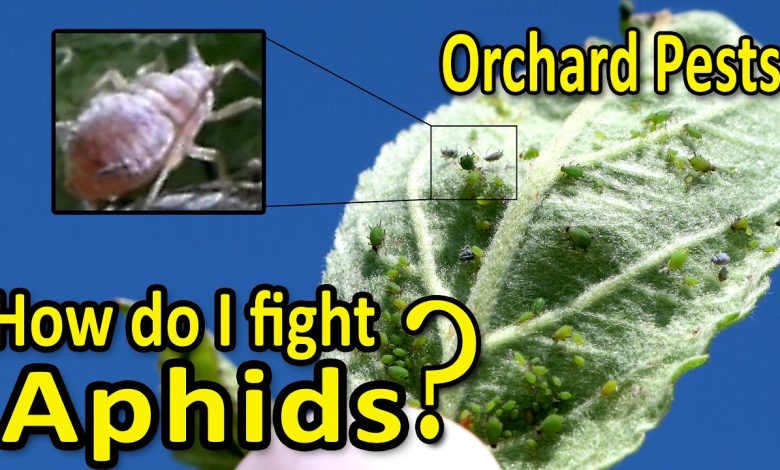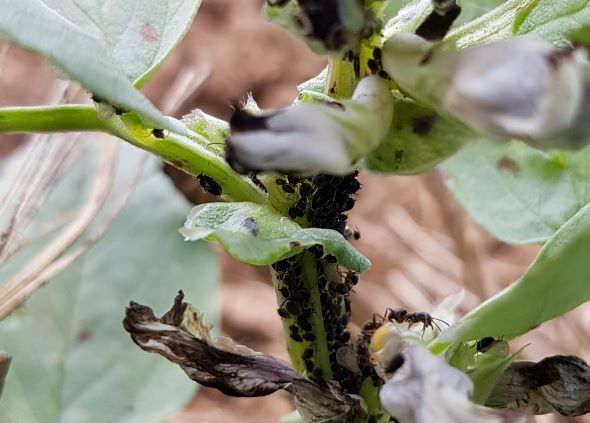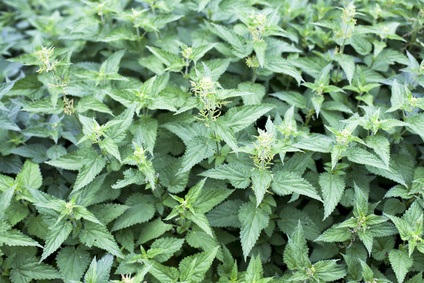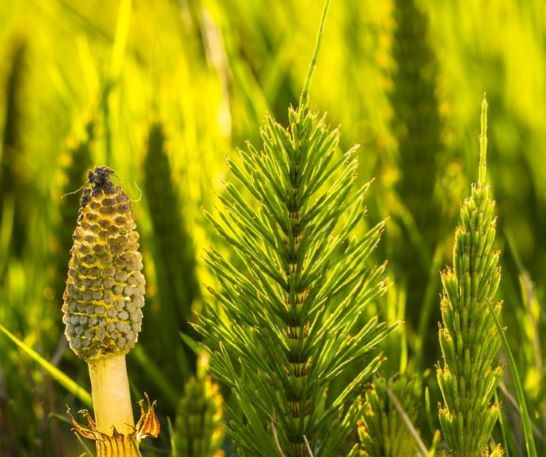11 Solutions to combat Aphids in the orchard

We wrote this article on solutions to combat aphids to try to help you with a very common problem that we find in our orchards. With good weather, the appearance of aphids on some of our plants is normal.

At AGROHUERTO.COM we have already given you a few tips about this insect, as you can see in the article “ Aphids: how we can control them ”.
What is an aphid?
It is a small insect of 1 to 3 mm in length that can have different colors, from strong green tones to black or gray. Although its morphology (ovoid and without visible distinction of the regions -head, thorax and abdomen-, four or six antennae and three ocelli) is practically the same between different species.
Most are polyphagous, that is, they are not picky about plants, they do not care what plant they eat. But they have a special predilection for sugar, which is why it is normal for them to eat crops with a high weight of sugar and from young areas of the crop.
The eggs hatch in spring and the larvae that emerge from them cause damage due to the construction of galleries in the leaves of the affected plant.
Adult aphids are slow and suck the sap from the leaves, they move slowly through the plant and feed by sucking the sap from the leaves, buds and young shoots producing deformations and spots.
In addition, aphids excrete a sticky, sugary liquid, honeydew, which not only covers the surface of the plant, but also attracts ants (as it serves as food for them). Something positive that we could take from this is that we can use the ants as an indicator. Namely; If we observe an increase in ants on a tree or plant, the fact that it is affected by an aphid may be a cause of this increase.

Another problem is that molasses can favor the appearance of a fungus, sooty mold or bold, which produces black soot-like spots that hinder photosynthesis and slow growth.
Another problem that we have to take into account is that aphids can function as virus vectors, that is; They can transmit viruses from one plant to another. Aphids that bite a plant infected with a virus will transmit it to other healthy plants that they feed on throughout their lives.
The aphid appears in dry areas and in optimum temperature conditions between 15ºC and 25ºC. Therefore, WATCH OUT in summer and at the end of spring.
Prevent the appearance of aphids
As always, preventive measures are very important. Lucía already explained to us in her article About her APHIDS: HOW WE CAN CONTROL THEM that we can carry out the following actions:
– Eliminate weeds.
– Adequate preparation and protection of the substrate
– If the presence of ants is detected, try to kill them as they have a symbiotic relationship with aphids: they protect and transport them to feed on the molasses they excrete.
– Plant, near the species that can be attacked by aphids, plants that repel them such as: basil (and aromatics in general), nettle or garlic.
– Paraffin oil or winter oil
How to fight aphids in the garden
Now once we unfortunately have it in our garden, what do we do? I recommend the following 11 solutions to combat the aphid:
1. Garlic infusion
It is a great repellant for aphids. We need 5 cloves of garlic and a liter of water. I leave you a video in which they explain them to us. Once prepared, if the garlic is not enough, you can enhance it with onion and pepper.
2. Onion infusion
It is similar to the previous one. In this case we need a medium onion per liter of water.
3. Wormwood (Artemisia absinthium)
In addition to being the plant from which absinthe and vermouth are obtained; it is an aphid repellent although it may be a better repellent against caterpillars. The best way against aphids is as 20% fermented slurry. It can also be prepared as an infusion if we boil 40 g of leaves per liter of water.
4. Vinegar against aphids
It may be another alternative. It should be sprayed directly on the plant. The preparation would be with water in equal parts.
5. Nettle slurry
It is one of the best solutions that we can use to combat the aphid. Nettle slurry (Urtica dioica) is used for many things such as fertilization or prevention. I leave you an explanatory video so that you can prepare it at home and its properties (not only as a repellent).

6. Soap solution
Neutral soap diluted in water can be used.
7. Ponytail
An infusion is made. It must be macerated for 24 hours and 100 grams are used in 1 liter of water. It is cooked and then diluted in five parts. It is sprayed on sunny days.
8. Chamomile
An infusion is made in which 50 grams of chamomile will be needed in 10 liters of water. It is diluted directly on the plant.
9. Lupine (Lupinus polyphyllus)
Another ornamental plant that works as an aphid repellent. It can be used in the form of slurry such as nettle.
10. Tansy (Tanacetum vulgare)
It is used as a general insecticide and 300 grams are used in 10 liters of water. We boil it for 10 minutes and let it rest for another 10. It is strained and applied directly to the plant.
11. Use of repellent plants or plants that attract beneficial insects.
As plants that repel aphids due to their smell or taste of the sap such as mint or lavender, or; insect attractants that can eat the aphid such as basil or calendula.

In this video, you will be able to see an explanation of the aphid and everything that I have talked about previously (I do not take into account the commercial products explained in the video):
References
- Schmidt MH, Lauer A, Purtauf T, Thies C, Schaefer M, Tscharntke T (2003).Relative importance of predators and parasitoids for cereal aphid control. Proceedings of the Royal Society B: Biological Sciences, 270, 1905–1909.
- Simon, J., Peccoud, J. (2018). Rapid evolution of aphid pests in agricultural environments. Current Opinion in Insect Science, 26, 17–24.
- Skirvin, DJ, Perry, JN, Harrington, R. (1997). ELUll A model describing the population dynamics of Sitobion avenae and Coccinella septempunctata. Ecological Modelling, 96, 29–39.
I hope these tips are useful to you and if you want to share any more with us, all you have to do is write to the Agrohuerto.com forum.
Have fun in the garden!

![Photo of Plague Thrips: [Detection, Steps to follow and Products to use]](https://www.complete-gardening.com/wp-content/uploads/2022/08/plague-thrips-detection-steps-to-follow-and-products-to-use-390x220.png)
![Photo of Kiwi cuttings: [Grafting, Season, Rooting and Sowing]](https://www.complete-gardening.com/wp-content/uploads/2021/06/Esquejes-de-Kiwi-390x220.jpg)
![Photo of Hostas: [Care, Sowing, Irrigation, Substrate and Possible Problems]](https://www.complete-gardening.com/wp-content/uploads/2021/06/hostas_1592773566-390x220.jpg)
![Photo of Alocasias: [Cultivation, Irrigation, Care, Pests and Diseases]](https://www.complete-gardening.com/wp-content/uploads/2022/08/alocasias-cultivation-irrigation-care-pests-and-diseases-390x220.jpg)